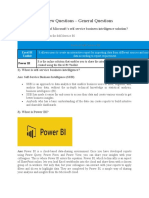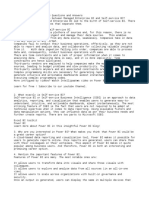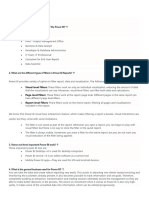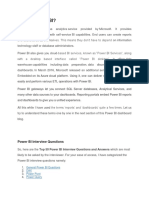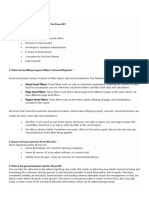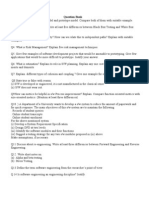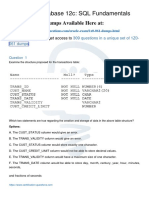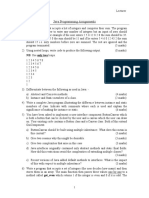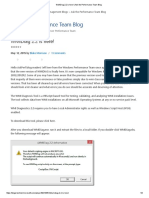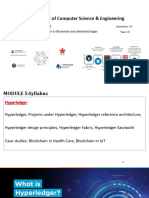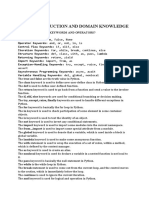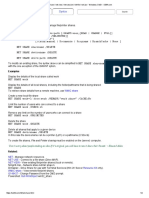Power Bi Notes
Uploaded by
aniruddhadighe897Power Bi Notes
Uploaded by
aniruddhadighe8971
NOTES OF POWER BI Mrs. Ashwini R. Amte
Power BI Interview Questions And Answers for the Mock
& MNC Co.
1). What are the parts of Microsoft’s self-service business intelligence
solution?
Ans: Microsoft has two parts for Self-Service BI
Parts of Self-Service BI
Excel BI It allows users to create an interactive report by importing data from different
Toolkit sources and model data according to report requirement.
It is the online solution that enables you to share the interactive reports and
Power BI
queries that you have created using the Excel BI Toolkit.
2). What is self-service business intelligence?
Ans: Self-Service Business Intelligence (SSBI)
• SSBI is an approach to data analytics that enables business users to filter,
segment, and, analyse their data, without the in-depth technical knowledge
in statistical analysis, business intelligence (BI).
• SSBI has made it easier for end-users to access their data and create
various visuals to get better business insights.
• Anybody who has a basic understanding of the data can create reports to
build intuitive and shareable dashboards.
3). What is Power BI?
POWER BI NOTES – ASHWINI R. AMTE
1
2
NOTES OF POWER BI Mrs. Ashwini R. Amte
Ans: Power BI is a cloud-based data-sharing environment. Once you have
developed reports using Power Query, Power Pivot, and Power View, you can
share your insights with your colleagues. This is where Power BI enters the
equation. Power BI, which technically is an aspect of SharePoint online, lets you
load Excel workbooks into the cloud and share them with a chosen group of co-
workers. Not only that, but your colleagues can interact with your reports to apply
filters and slicers to highlight data. They are completed by Power BI, a simple way
of sharing your analysis and insights from the Microsoft cloud.
Power BI features allow you to:
• Share presentations and queries with your colleagues.
• Update your Excel file from data sources that can be on-site or in the cloud.
• Display the output on multiple devices. This includes PCs, tablets, and HTML
5-enabled mobile devices that use the Power BI app.
• Query your data using natural language processing (or Q&A, as it is known).
4). How would you define Power BI as an effective solution?
Ans: PowerBI is a cloud based Business Intelligence tool to analyse and visualize
raw data that can be fetched from a wide range of data sources. It consolidates
business analytics with data visualization and helps any organization to make
business decisions based on data.It is easy to work with and the data is
processed in such a way that it is easy to understand and reliable. It can be
accessed from different platforms and can be shared across on-cloud
participants. Thus it is an effective solution.
5). What are the major components of Power BI?
Ans: The major components of PowerBI
are as follows :
POWER BI NOTES – ASHWINI R. AMTE
2
3
NOTES OF POWER BI Mrs. Ashwini R. Amte
Let’s discuss each component in brief:
Power Query: It is one of the most important components of PowerBI to
transform data. Power Query helps to extract data from different data sources
like Oracle, SQL, Text/CSV files, Excel, etc. and even delete data from different
sources.
Power Pivot : It is used for data modelling that uses DAX ( Data Analysis
Expression) functions for the calculations. Relationships between different tables
can also be created here and we can get values that can be shown in Pivot
Tables.
Power View: The Power View is used for providing an intuitive display of the
data and retrieving the metadata for data analysis. The views are interactive in
nature and slicers and filters can be used for slicing and dicing the data.
Power BI Desktop: Power Desktop is an integration tool for Power Query,
Power View, and Power Pivot. It helps to create advanced queries, data models,
reports and dashboards and helps in developing your BI skills for data analysis.
Power BI Mobile Application: It is available for the Operating systems Android,
iOS and even Windows. The App has an interactive display of the dashboards
which can be shared as well.
Power Map: It presents geo-spatial visualization of the data in 3 Dimensional
Mode. The data can be highlighted based on the geographical location which can
be continent, state, city or even street address.
Power Q&A : It is used to provide answers to the questions asked by users. It
works with Power View and can be answered with representations by Power
Q&A.
6). What are the various Power BI versions?
Ans: PowerBI has three versions currently:
Microsoft PowerBI Free/ Desktop – It is for anybody who wants to see their
business insights from the data with visualizations.
POWER BI NOTES – ASHWINI R. AMTE
3
4
NOTES OF POWER BI Mrs. Ashwini R. Amte
Microsoft PowerBI Pro – It is the full version of PowerBI which enables
unlimited viewing, reporting and sharing of reports which PowerBI Desktop
doesn’t support.
Microsoft PowerBI Premium – The Power BI Premium licence is not a per-user
licence, it provides a dedicated unit of capacity for all users in the organisation.
7). What is Power BI Desktop?
Ans: Power BI Desktop is a free desktop application that can be installed right on
your own computer. Power BI Desktop works cohesively with the Power BI service
by providing advanced data exploration, shaping, modeling, and creating reports
with highly interactive visualizations. You can save your work to a file or publish
your data and reports right to your Power BI site to share with others.
8). What do we understand by Power BI services?
Ans: PowerBI Services is a cloud based service or SaaS (software as a service). It
helps to connect to your data, analyse, visualize and share business insights with
efficiency.
9). What data sources can Power BI connect to?
Ans: The list of data sources for Power BI is extensive, but it can be grouped into
the following:
• Files: Data can be imported from Excel (.xlsx, xlxm), Power BI Desktop files
(.pbix) and Comma Separated Value (.csv).
• Content Packs: It is a collection of related documents or files that are
stored as a group. In Power BI, there are two types of content packs, firstly
those from services providers like Google Analytics, Marketo, or Salesforce,
and secondly those created and shared by other users in your organization.
• Connectors to databases and other datasets such as Azure SQL, Database
and SQL, Server Analysis Services tabular data, etc.
10). What are the different connectivity modes in Power BI?
Ans: There are three different connectivity modes in PowerBI which are:
POWER BI NOTES – ASHWINI R. AMTE
4
5
NOTES OF POWER BI Mrs. Ashwini R. Amte
Import Mode:
In PowerBI, Import Mode is the default mode since it is most frequently used
and delivers fast performance. It can integrate the data from a data source as
shown. Imported data is stored in the disk and it is fully loaded while querying or
refreshing.
Direct Query Mode
Microsoft Power BI Certification Training Course
Explore Curriculum
POWER BI NOTES – ASHWINI R. AMTE
5
6
NOTES OF POWER BI Mrs. Ashwini R. Amte
Direct Query Mode is another method of importing data with query to retrieve
data from a pre-existing data source. When the data volume is too large, we use
DirectQuery to avoid refreshing data as it can take a long time.
Composite Mode
This mode is an amalgamation of both Import and DirectQuery modes. This
mode supports calculated tables which DirectQuery doesn’t. It delivers the best
of Import Query and DirectQuery modes.
11). Where is the data stored in Power BI?
Ans: Primarily, PowerBI uses two repositories to store its data: Azure Blob
Storage and Azure SQL Database. Azure Blob Storage typically stores the data
that is uploaded by the users. Azure SQL Database stores all the metadata and
artifacts for the system itself.
POWER BI NOTES – ASHWINI R. AMTE
6
7
NOTES OF POWER BI Mrs. Ashwini R. Amte
12). What are Building Blocks in Power BI?
Ans: The following are the Building Blocks (or) key components of Power BI:
1. Visualizations: Visualization is a visual representation of data.
Example: Pie Chart, Line Graph, Side by Side Bar Charts, Graphical
Presentation of the source data on top of Geographical Map, Tree Map, etc.
2. Datasets: Dataset is a collection of data that Power BI uses to create its
visualizations.
Example: Excel sheets, Oracle or SQL server tables.
3. Reports: Report is a collection of visualizations that appear together on
one or more pages.
Example: Sales by Country, State, City Report, Logistic Performance report,
Profit by Products report etc.
4. Dashboards: Dashboard is single layer presentation of multiple
visualizations, i.e we can integrate one or more visualizations into one page
layer.
Example: Sales dashboard can have pie charts, geographical maps and bar
charts.
5. Tiles: Tile is a single visualization in a report or on a dashboard.
Example: Pie Chart in Dashboard or Report.
POWER BI NOTES – ASHWINI R. AMTE
7
8
NOTES OF POWER BI Mrs. Ashwini R. Amte
13). What is the comprehensive working system of Power BI?
Ans. Power BI’s working system mainly comprises four steps:
Data Importing: The first step is to import the data and convert it into a
standard format and store it in a staging area.
Data Cleaning: After assembling the data, it requires transformation or cleaning
to remove unimportant values.
Data Visualization: Now the data is visually represented on the Power BI
desktop as reports and dashboards using powerful visualization tools.
Save and Publish: Finally when your report is ready you can save and publish
these reports that can be shared across users via mobile apps or web.
14). What are content packs in Power BI?
Ans: Content packs for services are pre-built solutions for popular services as part
of the Power BI experience. A subscriber to a supported service, can quickly
connect to their account from Power BI to see their data through live dashboards
and interactive reports that have been pre-built for them. Microsoft has released
content packs for popular services such as Salesforce.com, Marketo, Adobe
Analytics, Azure Mobile Engagement, CircuitID, comScore Digital Analytix,
Quickbooks Online, SQL Sentry and tyGraph.
Organizational content packs provide users, BI professionals, and system
integrator the tools to build their own content packs to share purpose-built
dashboards, reports, and datasets within their organization.
15). What are the different types of filters in Power BI Reports?
POWER BI NOTES – ASHWINI R. AMTE
8
9
NOTES OF POWER BI Mrs. Ashwini R. Amte
Ans: Power BI provides variety of option to filter report, data and visualization.
The following are the list of Filter types.
• Visual-level Filters: These filters work on only an individual visualization,
reducing the amount of data that the visualization can see. Moreover,
visual-level filters can filter both data and calculations.
• Page-level Filters: These filters work at the report-page level. Different
pages in the same report can have different page-level filters.
• Report-level Filters: These filters work on the entire report, filtering
all pages and visualizations included in the report.
We know that Power BI visual has an interactions feature, which makes filtering a
report a breeze. Visual interactions are useful, but they come with some
limitations:
• The filter is not saved as part of the report. Whenever you open a report,
you can begin to play with visual filters but there is no way to store the filter
in the saved report.
• The filter is always visible. Sometimes you want a filter for the entire report,
but you do not want any visual indication of the filter being applied.
16). What is a dashboard?
Ans: A PowerBI dashboard is a canvas which creates a story with templates and
visualizations for better understanding of the data. It is a single-page report and
contains the highlights of the data.
POWER BI NOTES – ASHWINI R. AMTE
9
10
NOTES OF POWER BI Mrs. Ashwini R. Amte
17). What are the available views?
Ans: The different views in PowerBI are:
Report View : It is the default view which shows the visualization of the data in
reports. You can create multiple report pages here with a wide range of
templates and visualizations.
Data View : Data view shows the transformed data in a table format with
columns and rows. It also allows you to create new calculated columns for
further insights.
Model View : Also called, Relationship View, helps to create relationships
between data models. All the models created in the data can be seen in this view
and accordingly you can compare or create diagrams based on subsets of the
model.
18). What are the available formats?
Ans: Power BI is available in different formats:
POWER BI NOTES – ASHWINI R. AMTE
10
11
NOTES OF POWER BI Mrs. Ashwini R. Amte
Power BI desktop: You can download and install PowerBI Desktop on your
personal computer where you can connect to the data source, transform your
data, analyze and visualize it with templates.
Power BI services: It is a cloud based service or SaaS (software as a service).
You can connect to data here as well but the modeling is limited.
Power BI mobile app: One can securely access dashboards and reports on any
device with the PowerBI app which is available for iOs, Android and even
Windows.
19). What are the types of visualizations in Power BI?
Ans: In PowerBI, we can represent the data in graphs and visualizations. The visualization
can be of any type, for example:
Bar and Column Charts: It is a standard visualization for looking at a specific value across
various categories.
Area Charts( Basic and Stacked ) : It is based on the line chart and the area under the line.
It depicts the magnitude of change over time.
Card: Card shows aggregate value of a certain datapoint, can be one or more but one per
row.
Doughnut and Pie Charts: They show the relation in parts of a whole. Doughnut charts
have a hollow in the centre while pie charts don’t.
Maps: To show categorical and quantitative data with spatial locations.
Matrix: It’s a type of table with easier display that shows aggregated data
Slicers: Slicer is used to filter other visuals on the page.
There are other visuals like Combo Charts, Decomposition Tree, Funnel charts,
Gauge charts, KPIs, Line Charts, Ribbon Chart, Scatter, Q&A, Tables, Treemaps,
etc.
20). What are custom visuals in Power BI?
Ans: In PowerBI you can create your own visualizations from the library of
custom visualizations. A development project has to be created then test the
visual in PowerBI service. Once the visualization is customized, it is thoroughly
checked and tested before posting. After testing, the visualization is saved in
POWER BI NOTES – ASHWINI R. AMTE
11
12
NOTES OF POWER BI Mrs. Ashwini R. Amte
.pbiviz file format before sharing. But you need to be a PowerBI Pro user in
order to make custom visualizations.
21). Why and how would you use a custom visual file?
Ans: A custom visual file is used when none of the pre existing visuals fit the
business needs. Custom visual files are generally created by Developers which
can be used in the same way as prepackaged files.
22). What are the various type of users who can use Power BI?
Ans: PowerBI can be used by anyone for their requirements but there is a
particular group of users who are more likely to use it:
Report Consumers: They consume the reports based on a specific information
they need
Report Analyst: Report Analysts need detailed data for their analysis from the
reports
Self Service Data Analyst: They are more experienced business data users.
They have an in-depth understanding of the data to work with.
Basic Data Analyst: They can build their own datasets and are experienced in
PowerBI Service
Advanced Data Analyst: They know how to write SQL Queries and have hands-
on experience on PowerBI. They have experience in Advanced PowerBI with DAX
training and data modelling.
23).What are the critical components of the Power BI toolkit?
Ans: The most important components of PowerBI are:
Power Query
Power View
Power Pivot
Power Map
Power Q&A
Power Desktop
POWER BI NOTES – ASHWINI R. AMTE
12
13
NOTES OF POWER BI Mrs. Ashwini R. Amte
Power Website
PowerBI Mobile App
24). What is the maximum data limit per client for the free version of
Power BI?
Ans: With a Power BI Free licence a user can use 10 GB of storage in the cloud
for hosting Power BI reports. The maximum size a Power BI report can be used
in the cloud is 1GB.
25). Where do you reshape data in Power BI?
Ans: The data can be reshaped in Data Editing of PowerBI.
26). How can you refresh data in PowerBI?
Ans: The data can be refreshed in the Gateway in PowerBI by scheduling
refresh.
27). Which is a single-page canvas that uses visualizations to depict a story?
Ans: PowerBI service dashboard is a single-page canvas that uses
visualizations to depict a story.
28). Mention some advantages of Power BI?
Ans: Few advantages of using Power BI are :
• PowerBI can input a huge quantity of data
• Information can be visualized using powerful templates and visualizations
• Users get cutting edge intelligence technologies and powerful algorithms
that are updated regularly
• User can have personalised dashboards which are easy to access and
understand
• Users can perform queries on reports using DAX language
29). List out some drawbacks/limitations of using Power BI.
Ans: Some disadvantages of PowerBI are:
Complex in nature:
One major drawback of PowerBI is it is designed in a complex manner. One
needs complete knowledge of PowerBI in order to start working with PowerBI.
POWER BI NOTES – ASHWINI R. AMTE
13
14
NOTES OF POWER BI Mrs. Ashwini R. Amte
Large data:
PowerBI cannot handle large supply of data and might time out while processing
a large data.
PowerBI cannot process data more than 1 GB.
Limited Sharing of Data:
Reports can be shared only with users who have the same domain or have their
emails listed in the Office 365.
Limited data Source:
PowerBI can connect to real time data sets but there are very limited data
sources that allow real-time connection to the PowerBI dashboards.
Power BI DAX Interview Questions
30). What is DAX?
Ans: To do basic calculation and data analysis on data in power pivot, we use Data
Analysis Expression (DAX). It is a formula language used to compute calculated
column and calculated field.
• DAX works on column values.
• DAX can not modify or insert data.
• We can create calculated column and measures with DAX but we can not
calculate rows using DAX.
Sample DAX formula syntax:
For the measure named Total Sales, calculate (=) the SUM of values in the
[SalesAmount] column in the Sales table.
A- Measure Name
B- = – indicate beginning of formula
C- DAX Function
D- Parenthesis for Sum Function
E- Referenced Table
F- Referenced column name
POWER BI NOTES – ASHWINI R. AMTE
14
15
NOTES OF POWER BI Mrs. Ashwini R. Amte
31). What are the most common DAX Functions used?
Ans: Below are some of the most commonly used DAX function:
• SUM, MIN, MAX, AVG, COUNTROWS, DISTINCTCOUNT
• IF, AND, OR, SWITCH
• ISBLANK, ISFILTERED, ISCROSSFILTERED
• VALUES, ALL, FILTER, CALCULATE,
• UNION, INTERSECT, EXCEPT, NATURALINNERJOIN,
NATURALLEFTEROUTERJOIN,
SUMMARIZECOLUMNS, ISEMPTY,
• VAR (Variables)
• GEOMEAN, MEDIAN, DATEDIFF
32). What are the three fundamental concepts of DAX?
Ans: Three fundamental concepts of DAX are:
Syntax: Syntax is the formula which includes the functions. If a Syntax is
incorrect, it will result in an error.
Functions: Functions are arguments with specific orders to perform. It helps to
calculate any particular order as required.
Context: Context are of two types: Row Context and Filter Context. Row Context
is used when a formula has a Function that applies a filter to identify a row in a
table. Filter Context is used when one or more filters are used to get a value.
33). What are the purpose and benefits of using the DAX function?
Ans: DAX or Data Analysis Expression is a functional language which can create
calculated columns and/or measures for smarter calculations to limit the data
the dashboard has to fetch and visualize.
34). How is the FILTER function used?
Ans: The FILTER function returns a table with a filter condition applied for each of
its source table rows. The FILTER function is rarely used in isolation, it’s generally
used as a parameter to other functions such as CALCULATE.
• FILTER is an iterator and thus can negatively impact performance over large
source tables.
POWER BI NOTES – ASHWINI R. AMTE
15
16
NOTES OF POWER BI Mrs. Ashwini R. Amte
• Complex filtering logic can be applied such as referencing a measure in a
filter expression.
o FILTER(MyTable,[SalesMetric] > 500)
35). What is the CALCULATE function in DAX?
Ans: The CALCULATE function measures the sum of a column from any table
and can be modified with Filters.
Syntax:
CALCULATE ( <Expression> [, <Filter> [, <Filter> [, … ] ] ] )
31). What are the most common DAX Functions used?
Ans: Below are some of the most commonly used DAX function:
• SUM, MIN, MAX, AVG, COUNTROWS, DISTINCTCOUNT
• IF, AND, OR, SWITCH
• ISBLANK, ISFILTERED, ISCROSSFILTERED
• VALUES, ALL, FILTER, CALCULATE,
• UNION, INTERSECT, EXCEPT, NATURALINNERJOIN,
NATURALLEFTEROUTERJOIN,
SUMMARIZECOLUMNS, ISEMPTY,
• VAR (Variables)
• GEOMEAN, MEDIAN, DATEDIFF
32). What are the three fundamental concepts of DAX?
Ans: Three fundamental concepts of DAX are:
Syntax: Syntax is the formula which includes the functions. If a Syntax is
incorrect, it will result in an error.
Functions: Functions are arguments with specific orders to perform. It helps to
calculate any particular order as required.
Context: Context are of two types: Row Context and Filter Context. Row Context
is used when a formula has a Function that applies a filter to identify a row in a
table. Filter Context is used when one or more filters are used to get a value.
POWER BI NOTES – ASHWINI R. AMTE
16
17
NOTES OF POWER BI Mrs. Ashwini R. Amte
33). What are the purpose and benefits of using the DAX function?
Ans: DAX or Data Analysis Expression is a functional language which can create
calculated columns and/or measures for smarter calculations to limit the data
the dashboard has to fetch and visualize.
34). How is the FILTER function used?
Ans: The FILTER function returns a table with a filter condition applied for each of
its source table rows. The FILTER function is rarely used in isolation, it’s generally
used as a parameter to other functions such as CALCULATE.
• FILTER is an iterator and thus can negatively impact performance over large
source tables.
• Complex filtering logic can be applied such as referencing a measure in a
filter expression.
o FILTER(MyTable,[SalesMetric] > 500)
35). What is the CALCULATE function in DAX?
Ans: The CALCULATE function measures the sum of a column from any table
and can be modified with Filters.
Syntax:
CALCULATE ( <Expression> [, <Filter> [, <Filter> [, … ] ] ] )
Expression: The expression to be evaluated.
Filter: A boolean (True/False) expression or a table expression that defines a
filter.
36). What is special or unique about the CALCULATE and CALCULATETABLE
functions?
Ans: These are the only functions that allow you modify filter context of measures
or tables.
• Add to existing filter context of queries.
• Override filter context from queries.
• Remove existing filter context from queries.
POWER BI NOTES – ASHWINI R. AMTE
17
18
NOTES OF POWER BI Mrs. Ashwini R. Amte
Limitations:
• Filter parameters can only operate on a single column at a time.
• Filter parameters cannot reference a metric.
37). What is the common table function for grouping data?
Ans: SUMMARIZE()
• Main groupby function in SSAS.
• Recommended practice is to specify table and group by columns but not
metrics.You can use ADDCOLUMNS function.
SUMMARIZECOLUMNS
• New group by function for SSAS and Power BI Desktop; more efficient.
• Specify group by columns, table, and expressions.
38). What are some benefits of using Variables in DAX ?
Ans: DAX or Data Analysis Expression is a functional language which can create
calculated columns and/or measures for smarter calculations to limit the data
the dashboard has to fetch and visualise.
39). How would you create trailing X month metrics via DAX against a non-
standard calendar?
Ans: The solution will involve:
1. CALCULATE function to control (take over) filter context of measures.
2. ALL to remove existing filters on the date dimension.
3. FILTER to identify which rows of the date dimension to use.
Alternatively, CONTAINS may be used:
• CALCULATE(FILTER(ALL(‘DATE’),…….))
40). What are the different Excel BI add-in?
Ans: Below are the most important BI add-in to Excel:
• Power Query: It helps in finding, editing and loading external data.
• Power Pivot: Its mainly used for data modeling and analysis.
POWER BI NOTES – ASHWINI R. AMTE
18
19
NOTES OF POWER BI Mrs. Ashwini R. Amte
• Power View: It is used to design visual and interactively reports.
• Power Map: It helps to display insights on 3D Map.
Power BI Interview Questions – Power Pivot
41). What is Power Pivot?
Ans: Power Pivot is an add-in for Microsoft Excel 2010 that enables you to import
millions of rows of data from multiple data sources into a single Excel workbook.
It lets you create relationships between heterogeneous data, create calculated
columns and measures using formulas, build PivotTables and PivotCharts. You
can then further analyze the data so that you can make timely business decisions
without requiring IT assistance.
42). What is Power Pivot Data Model?
Ans: It is a model that is made up of data types, tables, columns, and table
relations. These data tables are typically constructed for holding data for a
business entity.
43). What is xVelocity in-memory analytics engine used in Power Pivot?
Ans: The main engine behind power pivot is the xVelocity in-memory analytics
engine. It can handle large amount of data because it stores data in columnar
databases, and in memory analytics which results in faster processing of data as
it loads all data to RAM memory.
44). What are some of differences in data modeling between Power BI
Desktop and Power Pivot for Excel?
Ans: Here are some of the differences:
• Power BI Desktop supports bi-directional cross filtering relationships,
security, calculated tables, and Direct Query options.
• Power Pivot for Excel has single direction (one to many) relationships,
calculated columns only, and supports import mode only. Security roles
cannot be defined in Power Pivot for Excel.
45). Can we have more than one active relationship between two tables in
data model of power pivot?
POWER BI NOTES – ASHWINI R. AMTE
19
20
NOTES OF POWER BI Mrs. Ashwini R. Amte
Ans: No, we cannot have more than one active relationship between two tables.
However, can have more than one relationship between two tables but there will
be only one active relationship and many inactive relationships. The dotted lines
are inactive and the continuous line is active.
Power BI Interview Questions – Power Query
46). What is GetData in Power BI?
Ans: With “Get Data” in PowerBI, you connect to different data sources to import
data for analysis and visualization. You can select from a range of various data
sources to import the desired data.
Eg. Text/CSV, Excel, PDF, JSON, Amazon Redshift, SQL Server database, Access
database, SAP HANA database, IBM, MySQL, Oracle database, Impala, Google
BigQuery,etc.
47). What is Power Query?
Ans: Power query is a ETL Tool used to shape, clean and transform data using
intuitive interfaces without having to use coding. It helps the user to:
• Import Data from wide range of sources from files, databases, big data,
social media data, etc.
• Join and append data from multiple data sources.
o Shape data as per requirement by removing and adding data.
48). What are the data destinations for Power Queries?
Ans: There are two destinations for output we get from power query:
1. Load to a table in a worksheet.
2. Load to the Excel Data Model.
49). What is query folding in Power Query?
Ans: Query folding is when steps defined in Power Query/Query Editor are
translated into SQL and executed by the source database rather than the client
machine. It’s important for processing performance and scalability, given limited
resources on the client machine.
POWER BI NOTES – ASHWINI R. AMTE
20
21
NOTES OF POWER BI Mrs. Ashwini R. Amte
50). What are some common Power Query/Editor Transforms?
Ans: Changing Data Types, Filtering Rows, Choosing/Removing Columns,
Grouping, Splitting a column into multiple columns, Adding new Columns ,etc.
51). Can SQL and Power Query/Query Editor be used together?
Ans: Yes, a SQL statement can be defined as the source of a Power Query/M
function for additional processing/logic. This would be a good practice to ensure
that an efficient database query is passed to the source and avoid unnecessary
processing and complexity
by the client machine and M function.
52). What are query parameters and Power BI templates?
Ans:Query parameters can be used to provide users of a local Power BI Desktop
report with a prompt, to specify the values they’re interested in.
• The parameter selection can then be used by the query and calculations.
• PBIX files can be exported as Templates (PBIT files).
• Templates contain everything in the PBIX except the data itself.
Parameters and templates can make it possible to share/email smaller template
files and limit the amount of data loaded into the local PBIX files, improving
processing time and experience.
53). Which language is used in Power Query?
Ans: A new programming language is used in power query called M-Code. It is
easy to use and similar to other languages. M-code is case-sensitive language.
54). Why do we need Power Query when Power Pivot can import data from
mostly used sources?
Ans: Power Query is a self-service ETL (Extract, Transform, Load) tool which runs
as an Excel add-in. It allows users to pull data from various sources, manipulate
said data into a form that suits their needs and load it into Excel. It is most
optimum to use Power Query over Power Pivot as it lets you not only load the data
but also manipulate it as per the users needs while loading.
POWER BI NOTES – ASHWINI R. AMTE
21
22
NOTES OF POWER BI Mrs. Ashwini R. Amte
55). Name some commonly used tasks in the Query Editor.
Ans: Some commonly used tasks in the Query Editor are:
Connect to Data: Get Data from various sources and Transform data.
Shape Data: Transform your data according to requirement to clean and shape it
Group Rows: You can group the values of many rows into one single value by
summarizing
Pivot Columns: Pivot columns and create a table with aggregated values
Create Custom Columns: You can use custom formulas to create new columns in
your table
Advanced Editor: You can make modifications to the data using Advanced Query
Editor with query. Power BI Interview Questions – Power Map
56). What is Power Map?
Ans: Power Map is an Excel add-in that provides you with a powerful set of tools
to help you visualize and gain insight into large sets of data that have a geo-coded
component. It can help you produce 3D visualizations by plotting upto a million
data points in the form of column, heat, and bubble maps on top of a Bing map.
If the data is time stamped, it can also produce interactive views that display, how
the data changes over space and time.
57). What are the primary requirement for a table to be used in Power Map?
Ans: For a data to be consumed in power map there should be location data like:
• Latitude/Longitude pair
• Street, City, Country/Region, Zip Code/Postal Code, and State/Province,
which can be geolocated by Bing
The primary requirement for the table is that it contains unique rows. It must also
contain location data, which can be in the form of a Latitude/Longitude pair,
although this is not a requirement. You can use address fields instead, such as
Street, City, Country/Region, Zip Code/Postal Code, and State/Province, which can
be geolocated by Bing.
58). What are the data sources for Power Map?
POWER BI NOTES – ASHWINI R. AMTE
22
23
NOTES OF POWER BI Mrs. Ashwini R. Amte
Ans: The data can either be present in Excel or could be present externally. To
prepare your data, make sure all of the data is in Excel table format, where each
row represents a unique record. Your column headings or row headings should
contain text instead of actual data so that Power Map will interpret it correctly
when it plots the geographic coordinates. Using meaningful labels also makes
value and category fields available to you when you design your tour in the Power
Map Tour Editor pane.
To use a table structure that more accurately represents time and geography
inside Power Map includes all of the data in the table rows, and use descriptive
text labels in the column headings, like this:
In case you wish to load your data from an external source:
1. In Excel, click Data > the connection you want in the Get External
Data group.
2. Follow the steps in the wizard that starts.
3. On the last step of the wizard, make sure Add this data to the Data
Model is checked.
The more you use it, the better you’ll get at it. So, let’s get started.
Power BI Interview Questions – Additional
Questions
59). Difference between Power BI and Tableau?
Ans: Both PowerBi and Tableau are business intelligence tools for generating
reports and data visualization but they do have a few significant differences.
Data Source:
PowerBI does not have as wide access to data sources as Tableau when
compared. Tableau has a wider range of access to various data sources.
Data Capacity:
POWER BI NOTES – ASHWINI R. AMTE
23
24
NOTES OF POWER BI Mrs. Ashwini R. Amte
Maximum of 10 GB of data can be handled in each workspace in PowerBI or else
it needs to be stored in the cloud.
While in Tableau, we can fetch billions of rows for each column as it works on
columnar based structure which stores unique values.
Machine Learning:
PowerBI has integration with Microsoft Azure which helps in analyzing the data.
Tableau has in-built Python machine learning capacities which makes it efficient
to perform ML Operations on datasets.
Performance:
PowerBI can handle a limited amount of data while Tableau can work with a
huge volume of data with ease.
Pricing:
PowerBI is cheaper compared to Tableau. Tableau needs to be paid more when
third party applications are connected.
60). What is Power View?
Ans: Power View is a data visualization technology that lets you create interactive
charts, graphs, maps, and other visuals which bring your data to life. Power View
is available in Excel, SharePoint, SQL Server, and Power BI.
The following pages provide details about different visualizations available in
Power View:
• Charts
• Line charts
• Pie charts
• Maps
• Tiles
• Cards
• Images
• Tables
• Power View
• Multiples Visualizations
• Bubble and scatter charts
• Key performance indicators (KPIs)
61). What is Power BI Designer?
POWER BI NOTES – ASHWINI R. AMTE
24
25
NOTES OF POWER BI Mrs. Ashwini R. Amte
Ans: It is a stand alone application where we can make Power BI reports and then
upload it to Powerbi.com, it does not require Excel. Actually, it is a combination of
Power Query, Power Pivot, and Power View.
62). Can we refresh our Power BI reports once uploaded to cloud (Share point
or Powebi.com)?
Ans: Yes we can refresh our reports through Data Management gateway(for
sharepoint), and Power BI Personal gateway(for Powerbi.com)
63). What are the different types of refreshing data for our published
reports?
Ans: There are four main types of refresh in Power BI. Package refresh, model or
data refresh, tile refresh and visual container refresh.
• Package refresh
This synchronizes your Power BI Desktop, or Excel, file between the Power BI
service and OneDrive, or SharePoint Online. However, this does not pull data from
the original data source. The dataset in Power BI will only be updated with what
is in the file within OneDrive, or SharePoint Online.
• Model/data refresh
It refers to refreshing the dataset, within the Power BI service, with data from the
original data source. This is done by either using scheduled refresh or refresh
now. This requires a gateway for on-premises data sources.
• Tile refresh
Tile refresh updates the cache for tile visuals, on the dashboard, once data
changes. This happens about every fifteen minutes. You can also force a tile
refresh by selecting the ellipsis (…) in the upper right of a dashboard and
selecting Refresh dashboard tiles.
• Visual container refresh
Refreshing the visual container updates the cached report visuals, within a report,
once the data changes.
To know more about data refresh and understand how to implement data
refresh, you can check the following link.
POWER BI NOTES – ASHWINI R. AMTE
25
26
NOTES OF POWER BI Mrs. Ashwini R. Amte
64). Is Power BI available on-premises?
Ans: No, Power BI is not available as a private, internal cloud service. However,
with Power BI and Power BI Desktop, you can securely connect to your own on-
premises data sources. With the On-premises Data Gateway, you can connect live
to your on-premises SQL Server Analysis Services and other data sources. You can
also schedule refresh with a centralized gateway. If a gateway is not available, you
can refresh data from on-premises data sources using the Power BI Gateway –
Personal.
65). What are the data management gateway and Power BI personal
gateway?
Ans: Gateway acts a bridge between on-premises data sources and Azure cloud
services.
Personal Gateway:
• Import Only, Power BI Service Only, No central monitoring/managing.
• Can only be used by one person (personal); can’t allow others to use this
gateway.
On-Premises Gateway:
• Import and Direct Query supported.
• Multiple users of the gateway for developing content.
• Central monitoring and control.
66). What is Power BI Q&A?
Ans: Power BI Q&A is a natural language tool that helps in querying your data and
getting the results you need from it. You do this by typing into a dialog box on
your Dashboard, which the engine instantaneously generates an answer similar
to Power View. Q&A interprets your questions and shows you a restated query of
what it is looking from your data. Q&A was developed by Server and Tools,
Microsoft Research, and the Bing teams to give you a complete feeling of truly
exploring your data.
POWER BI NOTES – ASHWINI R. AMTE
26
27
NOTES OF POWER BI Mrs. Ashwini R. Amte
67). What happens when you click the Infocus mode of a tile on the
PowerBI dashboard on the browser?
Ans: When you click the Infocus mode of a tile on the PowerBI dashboard on the
browser, the selected tile expands and takes the full space
68). How do you consolidate inquiries in Power BI?
Ans: Join Queries are used to consolidate inquiries in Power BI.
69). What are some ways that Excel experience can be leveraged with Power
BI?
Ans: Below are some of the ways through which we can leverage Power BI:
• The Power BI Publisher for Excel:
o Can be used to pin Excel items (charts, ranges, pivot tables) to Power
BI Service.
o Can be used to connect to datasets and reports stored in Power BI
Service.
• Excel workbooks can be uploaded to Power BI and viewed in the browser
like Excel Services.
• Excel reports in the Power BI service can be shared via Content Packs like
other reports.
• Excel workbooks (model and tables) can be exported to service for PBI
report creation.
• Excel workbook Power Pivot models can be imported to Power BI Desktop
models.
70). What is a calculated column in Power BI and why would you use them?
Ans: Calculated Columns are DAX expressions that are computed during the
model’s processing/refresh process for each row of the given column and can be
used like any other column in the model.
Calculated columns are not compressed and thus consume more memory and
result in reduced query performance. They can also reduce processing/refresh
performance if applied on large fact tables and can make a model more difficult
POWER BI NOTES – ASHWINI R. AMTE
27
28
NOTES OF POWER BI Mrs. Ashwini R. Amte
to maintain/support given
that the calculated column is not present in the source system.
71). How is data security implemented in Power BI ?
Ans: Power BI can apply Row Level Security roles to models.
• A DAX expression is applied on a table filtering its rows at query time.
• Dynamic security involves the use of USERNAME functions in security role
definitions.
• Typically a table is created in the model that relates users to specific
dimensions and a role.
72). What are many-to-many relationships and how can they be addressed
in Power BI ?
Ans: Many to Many relationships involve a bridge or junction table reflecting the
combinations of two dimensions (e.g. doctors and patients). Either all possible
combinations or those combinations that have occurred.
• Bi-Directional Crossfiltering relationships can be used in PBIX.
• CROSSFILTER function can be used in Power Pivot for Excel.
• DAX can be used per metric to check and optionally modify the filter
context.
73). Why might you have a table in the model without any relationships to
other tables?
Ans: There are mainly 2 reasons why we would have tables without relations in
our model:
• A disconnected table might be used to present the user with parameter
values to be exposed and selected in slicers (e.g. growth assumption.)
o DAX metrics could retrieve this selection and use it with other
calculations/metrics.
• A disconnected table may also be used as a placeholder for metrics in the
user interface.
o It may not contain any rows of data and its columns could be hidden
but all metrics are visible.
POWER BI NOTES – ASHWINI R. AMTE
28
29
NOTES OF POWER BI Mrs. Ashwini R. Amte
74). What is the Power BI Publisher for Excel?
Ans: You can use Power BI publisher for Excel to pin ranges, pivot tables and
charts to Power BI.
• The user can manage the tiles – refresh them, remove them, in Excel.
• Pinned items must be removed from the dashboard in the service
(removing in Excel only deletes the connection).
• The Power BI Publisher for Excel can also be used to connect from Excel to
datasets that are hosted in the Power BI Service.
• An Excel pivot table is generated with a connection (ODC file) to the data in
Azure.
The Publisher installs all necessary drivers on local machine to establish
connectivity .
75). What are the differences between a Power BI Dataset, a Report, and a
Dashboard?
Ans: Dataset: The source used to create reports and visuals/tiles.
• A data model (local to PBIX or XLSX) or model in an Analysis Services Server
• Data could be inside of model (imported) or a Direct Query connection to a
source.
Report: An individual Power BI Desktop file (PBIX) containing one or more report
pages.
• Built for deep, interactive analysis experience for a given dataset (filters,
formatting).
• Each Report is connected to atleast one dataset
• Each page containing one or more visuals or tiles.
Dashboard: a collection of visuals or tiles from different reports and, optionally,
a pinned.
• Built to aggregate primary visuals and metrics from multiple datasets.
76) What are the three Edit Interactions options of a visual tile in Power BI
Desktop?
Ans: The 3 edit interaction options are Filter, Highlight, and None.
POWER BI NOTES – ASHWINI R. AMTE
29
30
NOTES OF POWER BI Mrs. Ashwini R. Amte
Filter: It completely filter a visual/tile based on the filter selection of another
visual/tile.
Highlight: It highlight only the related elements on the visual/tile, gray out the
non-related items.
None: It ignore the filter selection from another tile/visual.
77). What are some of the differences in report authoring capabilities
between using a live or direct query connection such as to an Analysis
Services model, relative to working with a data model local to the Power BI
Desktop file?
Ans: With a data model local to the PBIX file (or Power Pivot workbook), the author
has full control over the queries, the modeling/relationships, the metadata and
the metrics.
With a live connection to an Analysis Services database (cube) the user cannot
create new metrics, import new data, change the formatting of the metrics, etc –
the user can only use the visualization, analytics, and formatting available on the
report canvas.
With a direct query model in Power BI to SQL Server, for example, the author has
access to the same features (and limitations) available to SSAS Direct Query
mode.
• Only one data source (one database on one server) may be used, certain
DAX functions are not optimized, and the user cannot use Query Editor
functions that cannot be translated into SQL statements.
78). How does SSRS integrate with Power BI?
Ans: Below are some of the way through which SSRS can be integrated with
Power BI:
• Certain SSRS Report items such as charts can be pinned to Power BI
dashboards.
• Clicking the tile in Power BI dashboards will bring the user to the SSRS
report.
POWER BI NOTES – ASHWINI R. AMTE
30
31
NOTES OF POWER BI Mrs. Ashwini R. Amte
• A subscription is created to keep the dashboard tile refreshed.
• Power BI reports will soon be able to be published to SSRS portal
-----------------------ALL THE BEST GUYS FOR YOUR GREAT FUTURE------------------------
POWER BI NOTES – ASHWINI R. AMTE
31
32
NOTES OF POWER BI Mrs. Ashwini R. Amte
POWER BI NOTES – ASHWINI R. AMTE
32
You might also like
- Power BI Interview Questions 1717598715No ratings yetPower BI Interview Questions 171759871524 pages
- POWER BI Interview Questions and Answer PDFNo ratings yetPOWER BI Interview Questions and Answer PDF4 pages
- Top 20 Power BI Interview Questions (2024) - JavatpointNo ratings yetTop 20 Power BI Interview Questions (2024) - Javatpoint16 pages
- Power BI: Features, Tools, and LimitationsNo ratings yetPower BI: Features, Tools, and Limitations5 pages
- Top 20 Power BI Interview Questions and AnswersNo ratings yetTop 20 Power BI Interview Questions and Answers8 pages
- Power BI Interview Questions For FreshersNo ratings yetPower BI Interview Questions For Freshers34 pages
- Powerbiinterviewquestionspdfbyscholarhat 240716104017 E79d91b9No ratings yetPowerbiinterviewquestionspdfbyscholarhat 240716104017 E79d91b918 pages
- Top 10 Beginner Level Power BI InterviewNo ratings yetTop 10 Beginner Level Power BI Interview12 pages
- Power BI Interview Questions For FreshersNo ratings yetPower BI Interview Questions For Freshers13 pages
- Top Power BI Interview Questions and Answers For 2022No ratings yetTop Power BI Interview Questions and Answers For 202219 pages
- Power BI Interview Questions With Answers For FreshersNo ratings yetPower BI Interview Questions With Answers For Freshers26 pages
- Powerbi Interview Questions: What Is Microsoft Power BI?No ratings yetPowerbi Interview Questions: What Is Microsoft Power BI?4 pages
- MBA IV Semester Business Intelligence PracticalLab Question Bank 2024No ratings yetMBA IV Semester Business Intelligence PracticalLab Question Bank 202420 pages
- Power Bi Interview Preparation: Andrey HakobyanNo ratings yetPower Bi Interview Preparation: Andrey Hakobyan12 pages
- Power BI Interview Questions and Answers For 2020No ratings yetPower BI Interview Questions and Answers For 202010 pages
- Oracle Database 12c: SQL Fundamentals: Oracle 1Z0-061 Dumps Available Here atNo ratings yetOracle Database 12c: SQL Fundamentals: Oracle 1Z0-061 Dumps Available Here at13 pages
- Blockchain Based Land Records System Using Hyperledger Fabric Ijariie22696No ratings yetBlockchain Based Land Records System Using Hyperledger Fabric Ijariie226966 pages
- RPA Automation Anywhere ADVANCE CERTIFICATIONNo ratings yetRPA Automation Anywhere ADVANCE CERTIFICATION3 pages
- Net Share - Net View - Net Session - Net File - Net Use - Windows CMD - SS64No ratings yetNet Share - Net View - Net Session - Net File - Net Use - Windows CMD - SS642 pages
- Resource 20241009095531 Cl-7 Ch-9 Cyber Threats - SecurityNo ratings yetResource 20241009095531 Cl-7 Ch-9 Cyber Threats - Security4 pages
- Service Desk Service Support AssessmentNo ratings yetService Desk Service Support Assessment44 pages
- Barracuda Web Application Firewall Best Practices Guide PDFNo ratings yetBarracuda Web Application Firewall Best Practices Guide PDF14 pages

